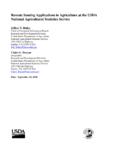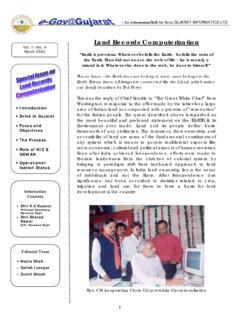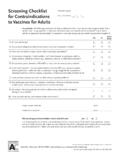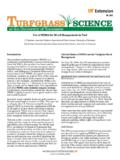Transcription of Hospital Disaster Preparedness Awareness …
1 Hospital Disaster Preparedness Awareness Training Part 1. Licensed & Non-Clinical Providers 2010 . FBN Number: 50-12426. CE. Broker 20-284722. Clinical Solutions - CEU: PART 1 is Intended for Awareness Level Personnel - All Hospital personnel, regardless of the type of emergency / Disaster encountered. Developed by: the State Working Group for Hospital Preparedness Training, Florida Department of Health and Florida Hospital Association. Revised by: Kristopher Pidgeon, RN, NREMT-P, CEN and Lotta Siegel, RN, BSN. PART 1 IS INTENDED FOR Awareness LEVEL PERSONNEL .. 1. The Purpose .. 3. Objective .. 4. Post-Test and Evaluation .. 4. Preparing for Disaster .. 5. Potential Hazards and 7. RAIN .. 8. Activation of the Disaster Plan .. 15. Personal 19. References & Resources .. 21. ALL HAZARDS Awareness LEVEL KEY POINTS .. 22. ALL HAZARDS Awareness LEVEL POST-TEST Error! Bookmark not defined. SELF- STUDY EVALUATION FORM.
2 Error! Bookmark not defined. WELCOME TO THE Awareness LEVEL PART1 OF THE FLORIDA. RECOMMENDED Hospital STAFF CORE COMPETENCIES FOR. Disaster Preparedness . Disaster Preparedness and management in healthcare has changed dramatically since September 11, 2001. Hospitals and clinics are "on the front lines" in incidents where nuclear, biological, explosive, or chemical agents are deliberately used as weapons in our communities. The severe hurricane season of 2004 also served to remind all Floridians that Disaster Preparedness is critical. Once again, hospitals and healthcare facilities were key components of our communities' Disaster management response. Florida Statute and JCAHO. standards require hospitals to have a comprehensive emergency management plan (CEMP). In the event of a natural or man-made Disaster , it is important for us to be prepared to respond. The Purpose The purpose of is program is to assist hospitals in the development, implementation, coordination, and evaluation of Disaster Preparedness and response training programs.
3 The updated 2006 Florida Recommended Hospital Staff Core Competencies for Disaster Preparedness are divided into three levels;. Awareness , mid, and advanced. This part, the Awareness level-PART 1, is designed for all Hospital personnel. Objective At the end of the educational opportunity, the participant will demonstrate knowledge in the area of Hospital Disaster Preparedness . A post-test will be administered and the participants will need a score of at least 75% to complete the course demonstrating Awareness of general Hospital roles and responsibilities for emergencies / disasters. Post-Test and Evaluation At the end of this presentation you will find a Course Evaluation tool as well as the post-test. Please fill both out and return them to Clinical Solutions for a certificate of completion to be completed. Preparing for Disaster As mentioned earlier, Disaster Preparedness and management in healthcare has changed dramatically since September 11, 2001.
4 Hospitals and clinics are "on the front lines" in incidents where nuclear, biological, explosive, or chemical agents are deliberately used as weapons in our communities. The severe hurricane season of 2004 also served to remind all Floridians that Disaster Preparedness is critical. Once again, hospitals and healthcare facilities were key components of our communities' Disaster management response. The purpose of a Disaster plan is to prepare us to respond and recover from a natural or man-made Disaster so that we may continue to provide treatment and patient care in extenuating circumstances. Natural disasters include hurricanes, tornadoes, and flooding. Examples of man-made disasters are explosions, chemical release, and a rare infectious disease outbreak. Every employee has a role and responsibilities in emergency / Disaster Preparedness . It is also important to make sure your personal Preparedness plans are up to date so that your family, including pets, is cared for during a Disaster .
5 The following educational opportunity will introduce you to the basics of Hospital Disaster plan and Awareness . What is a Hospital Disaster ? A " Disaster " can be defined as: Any natural or man-made event that significantly disrupts the normal mode of Hospital operations or results in a sudden, significant change or increased demand for the organization's services.. What are potential hazards and risks in your area? Risks o Large crowds o Schools, hospitals o Government buildings Hazards o Hurricane o Tornado o Fire Potential Hazards and Risks Some specific examples of potential hazards in your area may include: football games, art festivals, theme parks, nuclear power plants, etc. Other examples may include: industrial facilities, major transportation systems such as railroads, mail processing facilities, etc. It is important for all of us to examine our area for potential hazards, in order for us to be prepared for them.
6 Can you think of your geographical, demographical, or high risk areas of concern? Hospital Standard Emergency Codes These codes are our healthcare system's standardized emergency and Disaster codes. This is not to be confused with the Department of Homeland Security color code system. Signs are posted throughout your facilities displaying these codes. Most common healthcare example would be a Code Blue , which refers to a patient who is without consciousness, breathing, or a pulse. What can I do? RAIN. Disasters can happen to you at any time and it is important to be aware of your surroundings, know your role (what to do), and who to tell. R Recognize the presence of a hazard A Avoid Contamination through use of protection I Isolate hazards by securing the area N Notify appropriate higher level persons Recognize: Does it Belong ? o Unusual Activity / Behavior o Hazardous weather conditions o Things out of place Unexplained liquids Strange smells Abnormal fogs or mists Suspicious Packages You need to be able to Recognize the hazard: What do I see, hear, or smell?
7 This may include the presence of unusual activities or behaviors. Examples of unusual activities / behavior: Persons wearing inappropriate clothing for current weather conditions Hospital visitors exploring restricted areas Persons taking pictures of facilities Persons frequently visiting for inconsistent or unsubstantiated reasons Large vehicles parked in visitor areas ( large trucks in non-loading dock areas). Unattended packages Hazardous weather conditions: Typically, we are warned in advance of an impending hurricane; however, tornados may happen with little or no warning. Avoid: What do I Stay Away From? You need to remember that your safety is your safety is paramount. Think about the situation before acting to avoid becoming a victim. Take actions to avoid liquids, powders, clouds, or vapors and out of sight of any potential improvised explosive device. If you can see a bomb, then it can kill you is a good rule of thumb.
8 Apply the concepts of time, distance, and shielding. Avoiding exposure time to the threat, put distance between oneself and the threat, and protective equipment or barriers between oneself and the threat. Always use standard precautions: Proper hand washing is a great basic infection control method to protect yourself, staff, and patients. You should also consider alternative products to hand washing when necessary such as alcohol gels and foams. We should all routinely wipe down surfaces with surface wipes Ask if you are unsure it is better to be safe than sorry. If you need to wear a face mask, FIT testing and / or proper training is required. Please consult your Hospital provider for their policies and procedures. ISOLATE: Who Do I Keep Away ? Fire doors may be used to help contain a fire as well as support containment of a security threat or infectious area. It is each department's responsibility to know how to control and / or contain their area.
9 Access to critical areas must be controlled. It is important to note security needs. It is everyone's responsibility to assist with preventing unauthorized access. Do not open locked doors to persons outside. Watch for and report persons entering an isolated area, and make sure the appropriate signs are posted. Take action to isolate or reduce exposure to contamination or threats;. attempt to remove oneself from the contaminated zone, remove other people who may be in the contaminated zone, and keep people from going into the contaminated zone. Evacuation may be necessary. Notify: What Number Do I Call & Who Do I Call ? Any employee who encounters an emergency situation in which the health or safety of patients, staff, and/or visitors may be endangered will make notification of an internal emergency situation by advising Security and/or the Supervisor immediately of the type of event (This may be different in various facilities, so remember to follow the Hospital 's policy).
10 It is important to know what belongs in your area and what doesn't so that things like suspicious packages and chemical spills are recognized right away. Avoid touching or tasting unknown liquids, objects, packages, etc. Isolate and contain the area. Evacuation and / or decontamination may be necessary. Also remember to consider security concerns. Call for help and notify appropriate persons. RAIN EXAMPLE #1. Ex: Suspicious Package Recognize: Suspicious Package Avoid: Do not touch object Isolate: Contain the area & keep others away from hazard area Notify: Call for help If you should see a suspicious package it is imperative that you not touch it. Contact security right away. For bombs, cell phones may activate a bomb and need to be turned off. Notify Security and/or the Supervisor immediately of the type of event. RAIN EXAMPLE #2. Ex: Chemical Spill Recognize: Chemical Spill Avoid: Do not touch, taste, or smell Isolate: Contain the scene & keep others away from hazard area Notify: Call for help Observation of strange vapors and smells, or liquids of unusual color may identify chemical spills.








